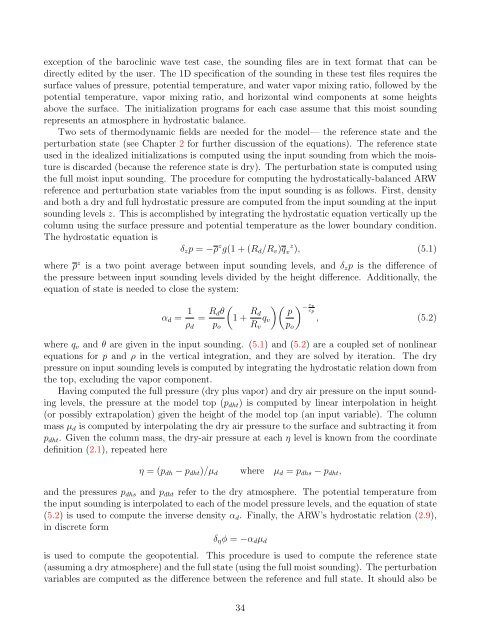Advanced Research WRF (ARW) Technical Note - MMM - University ...
Advanced Research WRF (ARW) Technical Note - MMM - University ...
Advanced Research WRF (ARW) Technical Note - MMM - University ...
You also want an ePaper? Increase the reach of your titles
YUMPU automatically turns print PDFs into web optimized ePapers that Google loves.
exception of the baroclinic wave test case, the sounding files are in text format that can be<br />
directly edited by the user. The 1D specification of the sounding in these test files requires the<br />
surface values of pressure, potential temperature, and water vapor mixing ratio, followed by the<br />
potential temperature, vapor mixing ratio, and horizontal wind components at some heights<br />
above the surface. The initialization programs for each case assume that this moist sounding<br />
represents an atmosphere in hydrostatic balance.<br />
Two sets of thermodynamic fields are needed for the model— the reference state and the<br />
perturbation state (see Chapter 2 for further discussion of the equations). The reference state<br />
used in the idealized initializations is computed using the input sounding from which the moisture<br />
is discarded (because the reference state is dry). The perturbation state is computed using<br />
the full moist input sounding. The procedure for computing the hydrostatically-balanced <strong>ARW</strong><br />
reference and perturbation state variables from the input sounding is as follows. First, density<br />
and both a dry and full hydrostatic pressure are computed from the input sounding at the input<br />
sounding levels z. This is accomplished by integrating the hydrostatic equation vertically up the<br />
column using the surface pressure and potential temperature as the lower boundary condition.<br />
The hydrostatic equation is<br />
δzp = −ρ z g(1 + (Rd/Rv)q v z ), (5.1)<br />
where ρ z is a two point average between input sounding levels, and δzp is the difference of<br />
the pressure between input sounding levels divided by the height difference. Additionally, the<br />
equation of state is needed to close the system:<br />
αd = 1<br />
ρd<br />
= Rdθ<br />
<br />
po<br />
1 + Rd<br />
qv<br />
Rv<br />
p<br />
po<br />
− cv<br />
cp<br />
, (5.2)<br />
where qv and θ are given in the input sounding. (5.1) and (5.2) are a coupled set of nonlinear<br />
equations for p and ρ in the vertical integration, and they are solved by iteration. The dry<br />
pressure on input sounding levels is computed by integrating the hydrostatic relation down from<br />
the top, excluding the vapor component.<br />
Having computed the full pressure (dry plus vapor) and dry air pressure on the input sounding<br />
levels, the pressure at the model top (pdht) is computed by linear interpolation in height<br />
(or possibly extrapolation) given the height of the model top (an input variable). The column<br />
mass µd is computed by interpolating the dry air pressure to the surface and subtracting it from<br />
pdht. Given the column mass, the dry-air pressure at each η level is known from the coordinate<br />
definition (2.1), repeated here<br />
η = (pdh − pdht)/µd where µd = pdhs − pdht,<br />
and the pressures pdhs and pdht refer to the dry atmosphere. The potential temperature from<br />
the input sounding is interpolated to each of the model pressure levels, and the equation of state<br />
(5.2) is used to compute the inverse density αd. Finally, the <strong>ARW</strong>’s hydrostatic relation (2.9),<br />
in discrete form<br />
δηφ = −αdµd<br />
is used to compute the geopotential. This procedure is used to compute the reference state<br />
(assuming a dry atmosphere) and the full state (using the full moist sounding). The perturbation<br />
variables are computed as the difference between the reference and full state. It should also be<br />
34
















